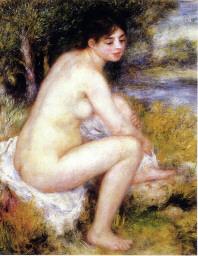Rome is gearing up for an important retrospective focusing on the groundbreaking effect a trip to Italy had on the works of 19th-century French artist Pierre-Auguste Renoir.
Curator Kathleen Adler says that Renoir had already turned his back on Impressionism - the movement that made him famous - by the time he took the voyage from October 1881 to January 1882.
She believes the visit was key to his subsequent development as an artist.
''Those few weeks spent in Italy provided a solid base for his new interests, exercising on him an influence that would last for the rest of his life,'' Adler said.
The exhibition at the Vittoriano Complex will showcase 130 works on loan from museums across the world that Renoir painted after his trip, during the last 40 years of his life.
Adler is keen to stress that while Renoir is thought of primarily as an Impressionist, his link with the movement was really a ''parenthesis'' that lasted between 1873 and 1877.
''That's a very short period in the arc of a very long career, and for that reason it's necessary to re-evaluate the 40 years that followed in a different light,'' she said.
Renoir started his career in Paris painting in the open air alongside his friend Claude Monet. After he was called up for the Franco-Prussian war, Renoir returned to Paris and spent several years on Impressionist painting before deciding the movement was what he described as ''a blind alley''.
''I milked Impressionism for all it was worth and I came to the conclusion that I couldn't draw or paint,'' Renoir wrote in 1880.
During his voyage to Italy a year later he visited Rome, Venice, Florence, Naples, Capri and Palermo, where he was bowled over by the experience of seeing classical and Renaissance art close up.
He was especially taken with the Raphael frescoes in the Villa Farnesina in Rome and the Pompeian wall paintings on show in the National Archaeological Museum in Naples.
Renoir's work underwent a profound stylistic transformation on his return from Italy as he turned further away from Impressionism's freely brushed touches of colour to concentrate on outlines, developing a more classical, linear style and increasing the solidity of his work.
Later he used a more delicate touch, blurring his outlines again in more stylized paintings.
On show in Rome are many of Renoir's portraits, images of women either officially posed or caught in daily activities, the faces of children and French landscapes.
A number of his famous bather pictures showing pearly-skinned women disrobing or drying off after a dip in the Seine are on display, along with two works that he painted during his Italian voyage: The Bay of Naples (1881), a landscape with Vesuvius looming in the background, and his portrait Head of a Neapolitan Girl (1881).
Towards the end of his life Renoir developed rheumatoid arthritis and had to paint with a brush strapped to his fingers.
In search of a drier climate he moved to the south of France, where he died aged 78 in 1919 from congestion of the lungs.
Pierre-Auguste Renoir - Tradition and Innovation runs at the Vittoriano in Rome from 7 March until 29 June.














